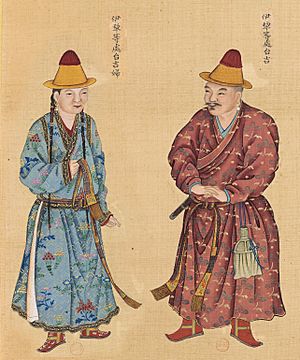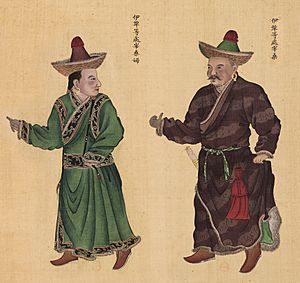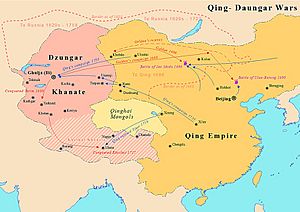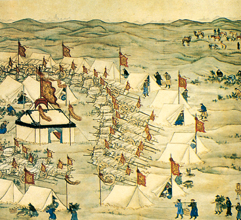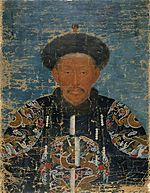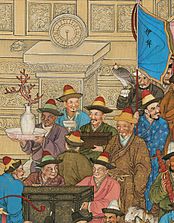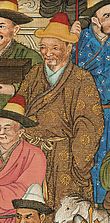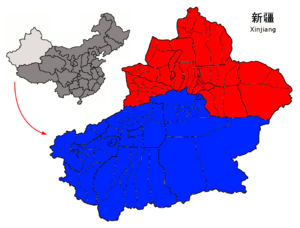Dzungar Khanate facts for kids
Quick facts for kids
Dzungar Khanate
|
|||||||||||||
|---|---|---|---|---|---|---|---|---|---|---|---|---|---|
| 1634–1755 | |||||||||||||
| Status | Nomadic empire | ||||||||||||
| Capital | Ghulja | ||||||||||||
| Common languages | Oirat, Chagatai | ||||||||||||
| Religion | Tibetan Buddhism | ||||||||||||
| Government | Monarchy | ||||||||||||
| Khan or Khong Tayiji | |||||||||||||
|
• 1632-1653
|
Erdeni Batur (first) | ||||||||||||
|
• 1671-1697
|
Galdan Boshugtu Khan | ||||||||||||
|
• 1745-1750
|
Tsewang Dorji Namjal | ||||||||||||
| Legislature |
|
||||||||||||
| Historical era | Early modern period | ||||||||||||
|
• Established
|
1634 | ||||||||||||
|
• 1619
|
The first Russian record of Khara Khula | ||||||||||||
|
• 1676
|
Galdan receives the title of Boshogtu khan from the 5th Dalai Lama | ||||||||||||
|
• 1688
|
The Dzungar invasion of the Khalkha | ||||||||||||
|
• 1690
|
Beginning of the Dzungar–Qing War, Battle of Ulan Butung | ||||||||||||
|
• 1755–1758
|
Qing army occupation of Dzungaria and genocide | ||||||||||||
|
• Disestablished
|
1755 | ||||||||||||
| Area | |||||||||||||
| 1650 | 3,600,000 km2 (1,400,000 sq mi) | ||||||||||||
| Population | |||||||||||||
|
•
|
600,000 | ||||||||||||
| Currency | pūl (a red copper coin) | ||||||||||||
|
|||||||||||||
| Dzungar Khanate | |||||||
|---|---|---|---|---|---|---|---|
| Chinese name | |||||||
| Traditional Chinese | 準噶爾汗國 | ||||||
| Simplified Chinese | 准噶尔汗国 | ||||||
|
|||||||
| Tibetan name | |||||||
| Tibetan | ཛེ་གུན་གར།། | ||||||
| Mongolian name | |||||||
| Mongolian Cyrillic | Зүүнгарын хаант улс | ||||||
| Mongolian script | ᠵᠡᠭᠦᠨ ᠭᠠᠷ ᠤᠨ ᠬᠠᠭᠠᠨᠲᠣ ᠣᠯᠣᠰ |
||||||
|
|||||||
| Uyghur name | |||||||
| Uyghur | جوڭغار Jongghar |
||||||
The Dzungar Khanate was a powerful empire in Inner Asia created by the Oirats, a group of Mongols. At its largest, it stretched from southern Siberia to modern-day Kyrgyzstan. It also reached from the Great Wall of China in the east to Kazakhstan in the west. The main part of the Dzungar Khanate is now northern Xinjiang, also known as Dzungaria.
Around 1620, the western Mongols, called the Oirats, came together in Dzungaria. In 1678, Galdan was given the title of Boshogtu Khan by the Dalai Lama. This made the Dzungars the most important tribe among the Oirats. Their rulers used the title Khong Tayiji, which means "crown prince." Between 1680 and 1688, the Dzungars took control of the Tarim Basin (southern Xinjiang today). They also defeated the Khalkha Mongols to the east.
However, in 1696, Galdan was defeated by the Qing dynasty and lost Outer Mongolia. In 1717, the Dzungars took over Tibet, but the Qing army forced them out a year later. In 1755, Qing China took advantage of a Dzungar civil war to conquer Dzungaria. The Qing then caused the near destruction of the Dzungars as a people. This event led to the Qing gaining control over Mongolia and Tibet, and the creation of Xinjiang as a new region.
Contents
- What's in a Name?
- A Look Back: Dzungar History
- What Happened Next
- Dzungar Khanate Leaders
- Dzungar Culture
- Images for kids
- See also
What's in a Name?
The name "Dzungar" comes from two Mongolian words: jegün (züün), meaning "left" or "east," and γar, meaning "hand" or "wing." The region of Dzungaria gets its name from this group. Even though the Dzungars were west of the Khalkhas, their name comes from being the "left wing" of the Oirats.
In the early 1600s, the Oirat leader, Gushi Khan, decided to invade Tibet. His army was split into a left and right wing. The left wing, which included the Choros and Khoid tribes, moved north into the Tarim basin. This powerful group became known as the Left Wing, or Zuungar.
European sources at the time sometimes called this region the Kingdom of the Eleuths. This name came from a misunderstanding of the name "Oirats" by French missionaries.
A Look Back: Dzungar History
How the Dzungars Began
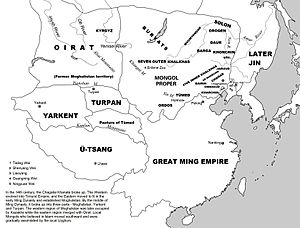
The Oirats originally lived in the area of Tuva in the early 1200s. Their leader, Quduqa Bäki, joined Genghis Khan in 1208. Over time, the Oirats faced conflicts with other Mongol groups and lost land.
In 1620, leaders of the Choros and Torghut Oirats fought against Ubasi Khong Tayiji, a Khalkha leader. Later, in 1625, a fight over inheritance broke out among the Khoshut Oirats. This led to some Oirat groups moving west. The Torghuts, for example, founded the Kalmyk Khanate far to the west.
In 1632, the Gelug Yellow Hat Buddhist group in Qinghai asked for help from Güshi Khan, an Oirat leader. In 1636, Güshi led 10,000 Oirats to invade Qinghai and defeated a much larger army. He then went to Central Tibet and received the title of "Dharma King" from the 5th Dalai Lama. Güshi Khan then claimed the title of Khan and helped create the Khoshut Khanate.
Among those involved was Erdeni Batur, who was given the title of Khong Tayiji. He married the Khan's daughter and returned to establish the Dzungar Khanate. Batur led several attacks against the Kazakhs, Kyrgyz, Tajiks, and Uzbeks.
Power Struggles: Dzungar Leaders
In 1653, Sengge became leader after his father Batur died. He faced challenges from his half-brothers but won with support from Ochirtu Khan. In 1670, Sengge was killed by his half-brothers.
Sengge's younger brother, Galdan Boshugtu Khan, was in Tibet studying to be a lama. When he heard about his brother's death, he returned. Galdan defeated his brothers and took control of Dzungaria. In 1671, the Dalai Lama made Galdan a Khan. Galdan later defeated his grandfather-in-law, Ochirtu, becoming the main leader of the Oirats. In 1678, the Dalai Lama gave him the even higher title of Boshoghtu Khan.
Taking Over the Yarkent Khanate (1678–1680)
From the late 1500s, the Yarkent Khanate was influenced by religious leaders called Khojas. These Khojas were Sufi Muslims. Two families of Khojas, the Aq Taghliq and Qara Taghliq, often fought each other.
In 1680, Galdan led 120,000 Dzungars into the Yarkent Khanate. They were helped by the Aq Taghliqs. The Dzungars easily defeated the local forces and captured the ruler, Ismail. Galdan then put Abd ar-Rashid Khan II, Ismail's son, in charge as a puppet ruler.
Wars with Neighbors
First Kazakh War (1681–1685)
In 1681, Galdan attacked the Kazakh Khanate but could not take the city of Sayram. In 1683, Galdan's armies, led by Tsewang Rabtan, captured Tashkent and Sayram. They reached the Syr Darya river and defeated two Kazakh armies. The Dzungars also took control of the Black Kyrgyz people and raided the Fergana Valley. From 1685, Dzungar forces pushed west, making the Kazakhs move further away.
Khalkha War (1687–1688)
The Oirats and Khalkha Mongols had been peaceful since 1634. However, a conflict between Khalkha leaders led Galdan to prepare for an attack. In 1688, Galdan's brother was killed in a battle against the Khalkhas. To get revenge, Galdan made friends with the Russians and, using Russian firearms, led 30,000 Dzungar troops into Khalkha Mongolia. He defeated the Khalkhas in three days. The Khalkha leaders then fled to the Qing dynasty and asked for protection from the Kangxi Emperor.
First Qing War (1690–1696)
In 1690, Galdan's army of 20,000 fought a Qing army near Beijing. Galdan was forced to retreat. In 1696, the Kangxi Emperor led 100,000 troops into Mongolia. Galdan was caught by another Qing army and defeated in the Battle of Jao Modo. Galdan's wife, Anu, was killed. Galdan fled with only a few followers and died in 1697. Back in Dzungaria, his nephew Tsewang Rabtan had already taken control.
Chagatai Rebellion (1693–1705)
After Galdan, the Dzungars faced more rebellions. The puppet ruler in the Yarkent Khanate was replaced by his brother Muhammad Imin Khan. Muhammad sought help from the Qing dynasty against the Dzungars. In 1693, Muhammad successfully attacked the Dzungar Khanate. However, a religious leader named Afaq Khoja led a revolt and overthrew Muhammad. Later, both Afaq and his son were killed. The Dzungars eventually installed a non-Chagatayid ruler, ending the rule of the Chagatai khans forever.
Second Kazakh War (1698)
In 1698, Galdan's successor, Tsewang Rabtan, reached Tengiz lake and Turkestan. The Dzungars controlled areas like Zhei-Su and Tashkent until 1745. The Dzungars' wars against the Kazakhs pushed them to seek help from Russia.
Second Qing War (1718–1720)
In 1717, Tsewang Rabtan's brother invaded the Khoshut Khanate and looted Lhasa, Tibet. The Kangxi Emperor sent an army in 1718, but it was destroyed by the Dzungars. A larger Qing army was sent in 1720, and they successfully drove the Dzungars out of Tibet. They brought the Kälzang Gyatso to Lhasa and made him the new Dalai Lama.
Galdan Tseren (1727–1745)
Tsewang Rabtan died in 1727, and his son Galdan Tseren took over. Galdan Tseren continued fighting against the Kazakhs and Khalkha Mongols. The Yongzheng Emperor of the Qing dynasty sent an army against the Dzungars, but they were defeated. However, the Dzungars lost a battle to the Khalkhas the next year. In 1739, Galdan Tseren agreed to a border between Khalkha and Dzungar lands.
The End of the Khanate (1745–1756)
Galdan Tseren died in 1745, which led to widespread unrest and a fight for power among his sons. In 1749, his son Lama Dorji took the throne from his younger brother. But Lama Dorji was then overthrown by his cousin Dawachi and a noble named Amursana. However, Dawachi and Amursana then started fighting each other for control.
Because of their conflict, some Dzungar relatives joined the Qing dynasty in 1753. The next year, Amursana also joined the Qing. In 1754, a ruler in Kashgar rebelled and forced Dzungars there to convert to Islam.
In the spring of 1755, the Qianlong Emperor sent a large army of 50,000 against Dawachi. The Qing army met almost no resistance and quickly defeated the Dzungar Khanate in about 100 days.
The Battle at Gädän-Ola (1755)
The Chinese army, helped by Muslim and Dzungar groups who had switched sides, surprised Dawachi in June 1755. Dawachi had about 10,000 troops and tried to retreat. A brave charge by a Dzungar who had joined the Qing, Ayusi, and 20 of his men, led to the capture of about 8,000 Dzungar soldiers. Dawachi escaped with only 2,000 men but was later captured by a Uyghur leader and handed over to the Qing.
Dawachi Surrenders (1755)
Dawachi surrendered to the Qing general Zhaohui. This moment was captured in a famous painting. Dawachi was taken to Beijing but was pardoned by the Emperor. He was even made a Prince.
Amursana's Rebellion (1755–1757)
After defeating the Dzungar Khanate, the Qing planned to appoint leaders for each of the four Oirat tribes. However, Amursana, who had helped the Qing, wanted to rule all the Oirats. The Qianlong Emperor only made him leader of the Khoid tribe.
In the summer, Amursana led a revolt against the Qing. He was defeated in the Battle of Oroi-Jalatu in 1756. Unable to defeat the Qing, Amursana fled to Russia and died of smallpox in 1757. His body was later brought to Kyakhta for the Manchu to see, but the Russians buried it.
Later, the remaining Dzungar forces were defeated in battles like the Battle of Khorgos (1758) and the Battle of Khurungui (1758).
What Happened Next
Paintings and Propaganda
The Qianlong Emperor wanted to show off his victories in the war. He ordered paintings of 100 brave Qing officers and generals, as well as some Oirat and Muslim allies. These paintings were made by foreign artists, especially Jesuits like Giuseppe Castiglione, and Chinese court painters. They showed the important officers who played key roles in the battles.
-
The Dörbed-Oirat Tseren in Qing dynasty clothes.
-
The Dörbed-Oirat Buyan Tegus in Qing dynasty clothes.
Muslim Uyghur Rebellions (1757–1759)
When Amursana rebelled against the Qing dynasty, two Muslim leaders, Burhanuddin and Jahan, also rebelled in Yarkand. Their rule was not popular. In February 1758, the Qing sent 10,000 troops against them. The Khoja brothers fled to Badakhshan, where they were captured and executed. Their heads were sent to the Qing. By 1759, the Tarim Basin was peaceful.
However, Muslim Uyghur revolts against the Qing continued for about 100 years.
The Dzungar People
Before the Qing conquest, the Dzungar population was around 600,000 people. Historians estimate that a large part of the Dzungar population was lost due to disease, fleeing to other areas, or being killed by the Qing army. Some historians describe this event as a "genocide."
The Qianlong Emperor gave strong orders to destroy the Dzungar people. His commanders were sometimes hesitant, but the Emperor repeated his orders for "extermination." The elderly, children, and women were often spared, but they lost their old names and titles.
Many former Dzungar subjects, like the Muslim Kazakhs and people from the Yarkent Khanate (now called Uyghurs), had been treated poorly by the Buddhist Dzungars. They helped the Qing invasion and attacked the Dzungars. Uyghur leaders were given titles by the Qing and helped convince other Muslims to aid the Qing in fighting the Oirats.
Changes in Xinjiang's Population

After the Dzungar people were largely destroyed, the Qing dynasty encouraged millions of people to settle in Dzungaria. These included Han Chinese, Hui Chinese, Xibe, Daur, Solon, Turkic Oasis people (Uyghurs), and Manchus. This is why modern Xinjiang's population mix still shows the effects of the Qing settlement policy.
The end of the Buddhist Dzungars led to Islam and its Muslim leaders becoming the main power in Xinjiang. Many Muslim Taranchis also moved to northern Xinjiang. Some historians say that the Qing victory actually helped Islam grow in the region, as Turkic Muslim culture was allowed or even promoted by the Qing.
In 1759, the Qing dynasty declared that the land that belonged to the Dzungars was now part of "China." The Qing wanted to show that different groups like Mongols, Oirats, and Tibetans were "one family" united under the Qing state.
Dzungar Khanate Leaders
- Khara Khula, title: Khong Tayiji
- Erdeni Batur, title: Khong Tayiji
- Sengge, title: Khong Tayiji
- Galdan Boshugtu Khan, titles: Khong Tayiji, Boshogtu Khan
- Tsewang Rabtan, title: Khong Tayiji, Khan
- Galdan Tseren, title: Khong Tayiji
- Tsewang Dorji Namjal, title: Khong Tayiji
- Lama Dorji, title: Khong Tayiji
- Dawachi, title: Khong Tayiji
- Amursana‡
‡ Note: Even though Amursana controlled some parts of Dzungaria from 1755–1756, he could not officially become Khan because his clan, the Khoid, was of a lower rank.
Dzungar Culture
The Oirats became followers of Tibetan Buddhism in 1615.
Oirat society was like other nomadic groups. They mainly raised animals but also did some farming. After taking over the Yarkent Khanate in 1680, they used people from the Tarim Basin as slave labor to farm land in Dzungaria.
The Dzungar economy and industries were quite advanced for a nomadic society. They had mines for iron, copper, and silver. From these raw materials, the Dzungars made weapons, shields, and even firearms and bullets. They were unique in Central Asia for being able to make their own firearms. In 1762, the Qing army found many Dzungar cannons and thousands of shells.
In 1640, the Oirats created a special law code called the Oirat Mongol Legal Code. This code helped organize the tribes and supported the Gelug Yellow Hat Buddhist group. Erdeni Batur also helped Zaya Pandita create the Clear Script, a writing system for the Oirat language.
Images for kids
See also
 In Spanish: Kanato de Zungaria para niños
In Spanish: Kanato de Zungaria para niños
- Choros (Oirats)
- Dzungar people
- Dzungaria
- Khoshut Khanate
- Kalmyk Khanate
- Tibet–Ladakh–Mughal War


